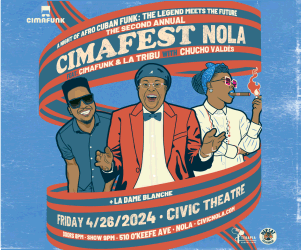Sergent Garcia’s, “Un Poquito Quema’o,” (“A Little Burnt”) shows the popular French band that mixes Latin dance music and Jamaican dub reggae in a fusion the French call “salsamuffin.” Bandleader Bruno “Sergent” Garcia, the son of a French mother and a Spanish father, is a refugee of the French punk-rock group, Ludwig Von 88. He is responsible for the unlikely mix of his band’s sound: salsa and/or dancehall reggae but with lyrics in Spanish (and/or French). Add to this Garcia’s interest in vague social protest in his lyrics, sometimes seeming to protest injustice but more often love songs built for dancing.
Of the dozen cuts on the CD, several are fairly straight-ahead salsa—if a tad campy—like “Si Yo Llego, Yo Llego” and “Camino de la Vida.” “Hoy Me Voy” is a kind of rhumba with a full brass section, clave beat and a piano solo.
But “Llevale Mi Canto” begins as a salsa and switches to ska/dancehall, which works well enough because salsa and ska both rely so heavily on the horn section. On this song, both music types are well done but presumably would make dancing to the song a musical chairs challenge as it switches tempos repeatedly from salsa to ska to salsa to dancehall. It also tacks on a chorus that sounds like funk/Latin ‘70s Mongo Santamaria, with a synthesizer. It’s an odd mixture that holds together only because the styles are all danceable.
“Medecine Man” is a decent dancehall reggae. “Oye Mi Bomba” is another dancehall sung in Spanish, though a bit silly. “Camino de La Vida” uses the structure from the soul song “What You See Is What You Get,” with a kind of dub in Spanish, sung by a woman, over Hammond organ fills and flute accents. “Mamaye” mixes Afro-Cuban call and response with a “Rock en Espanol” sound and Spanish dub reggae. “Que Palique” is a love song that happens to be an anti-war song that mentions Zorro and Don Quixote. Probably the most successful song on the record is “Jumpi,” a fast salsa with Spanish dub reggae lyrics and oddly enough, French rap. The song urges the listener to open his ears to all kinds of music, in a salsa homage to world music in general.
There are signs of newer influences appearing in a certain portion of Afro-Cuban music—Dominican rapper Kid Mangu being one example, and Havana clubs playing hip-hop another. Some Havana bands have added a more modern sensibility into the hottest current Cuban music, timba, but for the most part those natural influences come from jazz. Although Cuba and Jamaica are just a hundred miles apart, Cuban music is such a powerhouse that reggae has never really been mixed into it. Ska is the Latinized version of early reggae, but music of Cuban origin has yet to be profoundly influenced by any outside sources besides jazz. Even so, outsiders like Bruno Garcia prove that the two musics can be harmoniously mixed.
Sergent Garcia’s thing is at times a bit cartoonish, and seems filtered through a young European’s fantasies of salsa and reggae music playing as background in a spaghetti western. I assume that when Bruno Garcia names his two major influences as Busta Rhymes and Irakere that he’s not quite serious. Garcia has joked that he watched too much television as a boy and indeed his whole Sergent persona is derived from a nickname after the mean sergeant in the “Zorro” television show. Although the record is energetic and danceable, the band is at its best sticking close to salsa; it grooves most when it doesn’t stray from a clave beat. The kitschier stuff is less satisfying. This may be an inventive record, though it is probably more attractive to young club-hanging Parisians or Madrilenos than Americans who love salsa or reggae.




